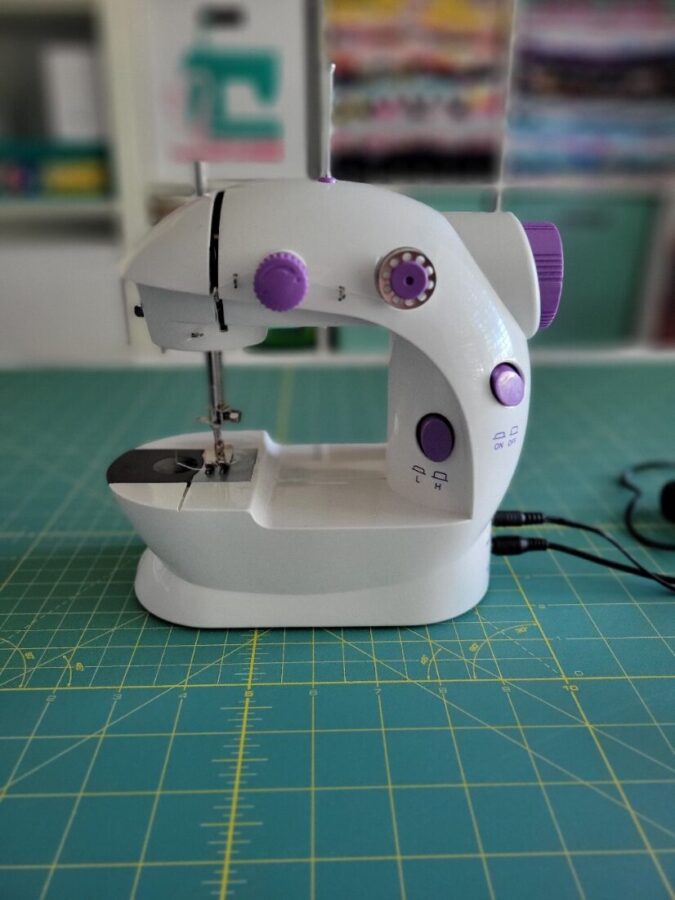Hello, fellow fabric enthusiasts! Luna here, your guide to the magical world of sewing. If you’ve been curious about those mini sewing machines popping up everywhere, you’ve come to the right place!
My Mini Sewing Machine Experiment
In my quest to find the perfect sewing starter kit for my daughter, I stumbled upon a mini sewing machine. Compact and light as a feather, not to mention easy on the wallet. Yet, it fell short of expectations and, spoiler alert, it wasn’t the machine my daughter began her sewing journey with. But don’t dismiss these petite machines yet; they might just suit certain crafters out there. Dive into my review for the ins and outs of these tiny tailoring tools!
The Hunt on Amazon
My adventure on Amazon was a dizzying dance of comparison until I uncovered a truth: many of these machines are clones with a dash of rebranding for the American market. Most hail from the same factories in China. So here’s a nugget of wisdom: don’t sweat over the subtle differences between these mini models. Focus on whether they’re the right fit for your sewing aspirations.
Are Mini Sewing Machines Up to Snuff?
Let’s cut to the chase. For the majority, a mini sewing machine is a nifty novelty at best. It’s akin to a toy and won’t be a steadfast companion on your sewing odyssey, especially if you aim to go beyond the basics. I’d hesitate to recommend it for younglings or novices, as its simplicity can be deceiving. The ideal candidate? Perhaps a traveler, a hobbyist in need of a battery-operated device, or someone sticking to a tight budget.
Pros and Cons of Going Mini
Everything has its ups and downs, and these pint-sized machines are no exception. Here are seven perks before we delve into the downsides:
- Affordability: They won’t break the bank, costing less than $50.
- Battery Operation: No outlet? No problem. Just pop in some AA batteries.
- Accessories Galore: Many come with a treasure trove of sewing goodies.
- Portability: Weighing about 3 pounds, it’s the epitome of portable.
- Familiar Components: Uses standard needles and metal bobbins.
- Swift Stitching: Surprisingly quick, despite its size.
- Foot Pedal or Button: You choose how to drive your sewing experience.
But let’s be real, there are several areas where these machines could use a tune-up:
- Stitch Variety is nonexistent; you’re stuck with a single straight stitch.
- Thick fabrics? Stretchy materials? Unfortunately, it’s not that versatile.
- A tiny workspace that can be challenging for larger hands.
- Quality control seems to be hit or miss with these machines.
- They’re noisier than their size would suggest.
- The power cord is laughably short.
- Troubleshooting issues can be a real headache.
For a full breakdown of how to set up and troubleshoot these compact machines, check out my comprehensive guides on threading and usage – trust me, you’ll need them given the lackluster instructions provided.
Final Musings on Mini Machines
If I were marooned on a desert isle with no power, a mini sewing machine might just be my saving grace. But back in civilization, I’m all for the robust, feature-rich full-sized machines. They’re an investment that grows with you, from beginner to pro. As the saying goes, you get what you pay for, and these minis are on the lower end of the spectrum. Now, I’d love to hear your experiences and thoughts!
Quick Glance: Mini Sewing Machine Breakdown
| Pros | Cons |
|---|---|
| Cheap | Limited stitch options |
| Battery-powered | Struggles with varied fabrics |
| Accessory-rich | Cramped workspace |
| Ultra-portable | Inconsistent quality |
| Fast stitching | Noisy for its size |
| Optional foot pedal | Short power cord |
| Better than handheld | Troubleshooting difficulties |

